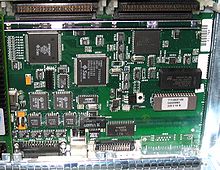SBus

The SBus is an expansion card bus developed by Sun Microsystems for its own SPARCstation workstations . Originally the bus was 32 bits wide at a clock frequency of 16.67-25 MHz . In later specifications, the bus was expanded to include so-called D64 operations (64 bit) and the clock frequency was doubled. The SPARCstation 1 was the first workstation with this bus in 1989 .
In its time, the bus was considered to be very powerful and, with its data throughput of 168 MByte / second, could still keep up in many areas today (for comparison, the 32-bit @ 33 MHz PCI bus five years younger reaches 133 MByte / second, 64-bit 66 MHz PCI reaches 528 Mbytes / second). However, the bus has not found widespread use outside of SPARC based computers. Sun replaced it in its own workstations in 1997 with the PCI bus. Even Sun's generous licensing policy (free of charge) and the standardization by the IEEE did not lead to a spread outside the Sun world. SBus cards were and are also disproportionately expensive. Among other things, this is a result of the card format.
The format of the SBus cards is unusual. The cards are relatively small (8.38 cm × 14.67 cm) and in contrast to typical PC plug-in cards, SBus cards do not stand, but lie. The plug connection is located on the underside instead of on one long side. The specification allows double-width cards that occupy two SBus slots located next to each other. The format forced card manufacturers to have a high level of integration for the time. The SBus cards fit well into the housing concept for SPARCstations with the legendary pizza box format. Today Sun uses PC-like cases.
Since SPARCstations only had a few SBus slots (one to four depending on the model), expansion boxes from Sun and other manufacturers quickly emerged. These led an SBus slot via an SBus card and a short cable (maximum 50 cm) to the outside and connected three or four slots in an external housing (usually also a "pizza box") to this slot. These designs were very unreliable in operation because the SBus was not electrically suitable for such expansions. In real continuous operation, expansion boxes were therefore partially unusable. This, too, has harmed the spread of the SBus.
The expansion box sold by Sun had the same housing as the SparcStation2, which was popular at the time, with the exception of the missing floppy bay. In addition to three slots for SBus cards, it offered space for two hard drives, but did not have its own SCSI controller. For the operation of hard disks within the expansion box, this had to be connected to the external SCSI connection of the host system via an additional cable. Although the label on the housing bears the inscription "SBus-Expansion", the box and its SBus card are recognized by many operating systems (including Solaris ) as "xbox" - this term was not invented by Microsoft.
See also
- MBus - Sun's bus for CPU modules in SPARC multiprocessor systems
literature
- SBus Specification B.0, 800-5922-10, Sun Microsystems.
- IEEE Standard 1496-1993 SBus , ISBN 0-7381-2917-8 ( at IEEE )
- K. Dembowski: Computer interfaces and bus systems Markt & Technik Verlag, Haar 1993, ISBN 3-87791-440-3


